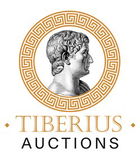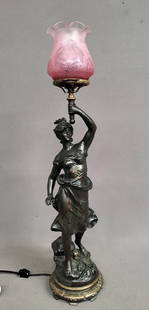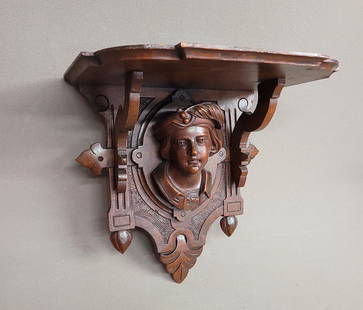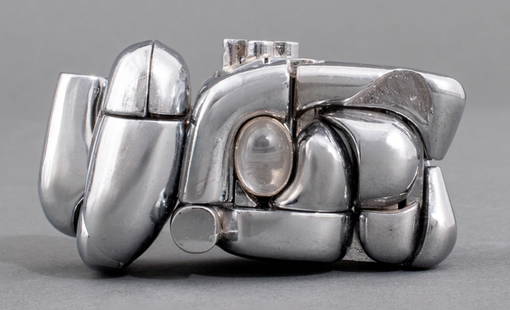








Item Details
Description
Artus Quellinus I
Antwerpen 1609 - 1668 Antwerpen, circle of
Museum-quality figural group of the Entombment
Flemish
Around 1640
Length 50 cm, height 44 cm, depth 30 cm
Artus Quellinus was a Flemish sculptor who played an important role in the development of Northern European sculpture of the High Baroque.
The all-visible Entombment of Christ is a masterful classicist-baroque work in marble. It was probably made around the middle of the 17th century by a Flemish sculpture workshop in the circle of Artus Quellinus I (1609-1668), who was strongly influenced by the style of Roman classicism of Francois Duquesnoy (1597-1643). The dimensions (50 x 44 x 30 cm) form a formidable group, located between monumental sculpture and small sculpture.
In pyramidal composition, three figures are shown in a Passion motif depicting the moment between the Descent from the Cross and the Entombment, uniting it with the popular scene of the Lamentation of Christ. Christ's corpse, partly slung limply, partly muscularly tense, is supported on an indeterminate ground of drapery and is supported by the two supporting figures. Both are turned towards the central figure in deep contemplation, whose face is already lifelessly turned towards heaven. The kneeling youth presses his fingers into the upper arm muscles of the dead man, allowing emotion to come through, further emphasizing his sad face. This restraint is broken by the other figure: The woman embraces Christ's left hand and nestles her face against the back of his hand in deep sorrow. The thick, open hair is fanned out over her back, also suggesting emotional turmoil. Her youthful face suggests that she is Mary Magdalene. Particularly striking is the figures' sparse, antique-style clothing, which situates the scene in an ancient setting and assigns it to the style of the classicist Baroque. Here, ornamentally animated drama gives way to a contemplative, emotive variant of expression reminiscent of antique sculpture. The soft modeling of the supporting figures contrasts with the anatomically perfectly rendered, muscular and sinewy body of Christ. This hyperrealism and the taut body dynamics of Christ already anticipate the imminent resurrection (cf. antique torso from the Belvedere). The smallest details such as the stigmata on his chest, the openwork curls and his fingernails are meticulously worked out.
Those withdrawn classical features are significantly influenced by Francois Duquesnoy, a representative of Roman classicism. The latter studied in Rome and not only made small and monumental sculptures there, but was also entrusted with the restoration of ancient statues. As one of the most important Roman sculptors of the 17th century, his style significantly influenced later artists, including Artus Quellinus the Elder, who was even trained by Duquesnoy. He returned to Amsterdam, however, where he was accepted into the Antwerp Guild of St. Luke. In a contrasting mixture of antic soft modeling and expressively dynamic physiognomy, the artist of the sculpture presented here also directs the focus to the central figure of Christ. The clay bozzetto "Samson and Delila" (Staatliche Museen zu Berlin) can serve as a comparative example. The careful treatment of the surfaces and the silent, emotional dialogue between the depicted figures testify to Duquesnoy's classical inspirations; the complex, dynamically proportioned body brings to mind the lush Baroque painting of Peter Paul Rubens, who was even a good friend and teacher of the Quellinus family. The painterly impression and the high degree of technical expertise testify to the unification of baroque stylistic devices, creating in masterly style a scene with an emotive message.
Antwerpen 1609 - 1668 Antwerpen, circle of
Museum-quality figural group of the Entombment
Flemish
Around 1640
Length 50 cm, height 44 cm, depth 30 cm
Artus Quellinus was a Flemish sculptor who played an important role in the development of Northern European sculpture of the High Baroque.
The all-visible Entombment of Christ is a masterful classicist-baroque work in marble. It was probably made around the middle of the 17th century by a Flemish sculpture workshop in the circle of Artus Quellinus I (1609-1668), who was strongly influenced by the style of Roman classicism of Francois Duquesnoy (1597-1643). The dimensions (50 x 44 x 30 cm) form a formidable group, located between monumental sculpture and small sculpture.
In pyramidal composition, three figures are shown in a Passion motif depicting the moment between the Descent from the Cross and the Entombment, uniting it with the popular scene of the Lamentation of Christ. Christ's corpse, partly slung limply, partly muscularly tense, is supported on an indeterminate ground of drapery and is supported by the two supporting figures. Both are turned towards the central figure in deep contemplation, whose face is already lifelessly turned towards heaven. The kneeling youth presses his fingers into the upper arm muscles of the dead man, allowing emotion to come through, further emphasizing his sad face. This restraint is broken by the other figure: The woman embraces Christ's left hand and nestles her face against the back of his hand in deep sorrow. The thick, open hair is fanned out over her back, also suggesting emotional turmoil. Her youthful face suggests that she is Mary Magdalene. Particularly striking is the figures' sparse, antique-style clothing, which situates the scene in an ancient setting and assigns it to the style of the classicist Baroque. Here, ornamentally animated drama gives way to a contemplative, emotive variant of expression reminiscent of antique sculpture. The soft modeling of the supporting figures contrasts with the anatomically perfectly rendered, muscular and sinewy body of Christ. This hyperrealism and the taut body dynamics of Christ already anticipate the imminent resurrection (cf. antique torso from the Belvedere). The smallest details such as the stigmata on his chest, the openwork curls and his fingernails are meticulously worked out.
Those withdrawn classical features are significantly influenced by Francois Duquesnoy, a representative of Roman classicism. The latter studied in Rome and not only made small and monumental sculptures there, but was also entrusted with the restoration of ancient statues. As one of the most important Roman sculptors of the 17th century, his style significantly influenced later artists, including Artus Quellinus the Elder, who was even trained by Duquesnoy. He returned to Amsterdam, however, where he was accepted into the Antwerp Guild of St. Luke. In a contrasting mixture of antic soft modeling and expressively dynamic physiognomy, the artist of the sculpture presented here also directs the focus to the central figure of Christ. The clay bozzetto "Samson and Delila" (Staatliche Museen zu Berlin) can serve as a comparative example. The careful treatment of the surfaces and the silent, emotional dialogue between the depicted figures testify to Duquesnoy's classical inspirations; the complex, dynamically proportioned body brings to mind the lush Baroque painting of Peter Paul Rubens, who was even a good friend and teacher of the Quellinus family. The painterly impression and the high degree of technical expertise testify to the unification of baroque stylistic devices, creating in masterly style a scene with an emotive message.
Buyer's Premium
- 32%
Artus Quellinus I, Antwerp 1609 - 1668 Antwerp, circle of, museum-quality figure group of the
Estimate €20,000 - €25,000
Starting Price
€10,000
3 bidders are watching this item.
Get approved to bid.
Shipping & Pickup Options
Item located in Vienna, Austria, ATSee Policy for Shipping
Local Pickup Available
Payment

12th Tiberius Auction - Day 2
Vienna, Austria, AT
Related Sculptures & Carvings
More Items in Sculptures & Carvings
View MoreRecommended Art
View MoreRelated Searches
TOP





















































































